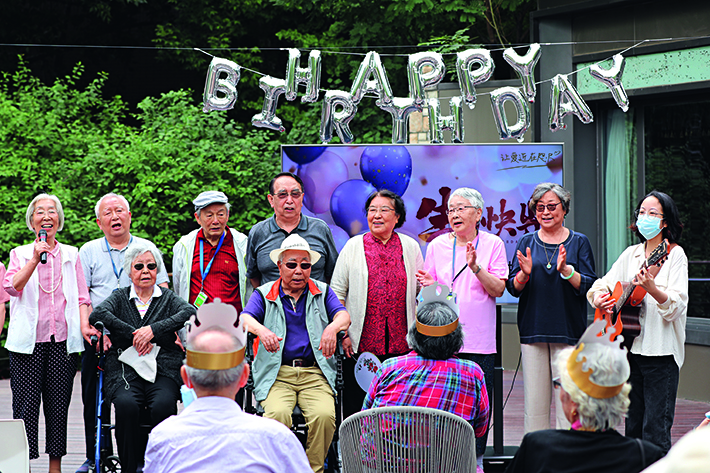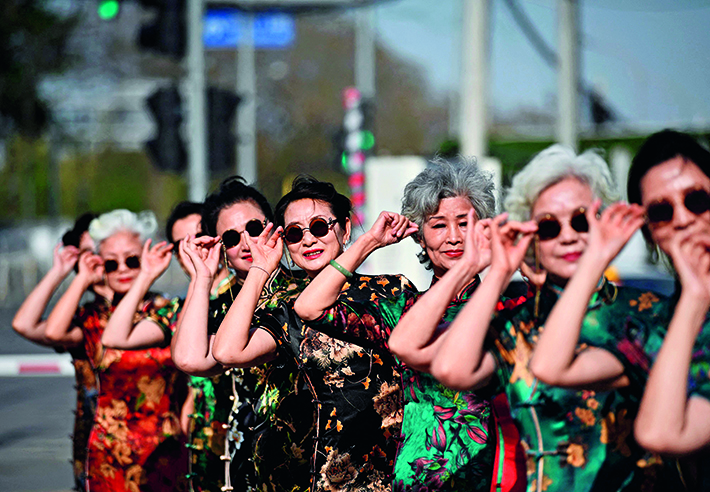|
||||||||||
| Home Nation World Business Opinion Lifestyle ChinAfrica Multimedia Columnists Documents Special Reports |
|
||||||||||
| Home Nation World Business Opinion Lifestyle ChinAfrica Multimedia Columnists Documents Special Reports |
| ChinAfrica |
| Diversified Elderly Care |
| China is striving to build an elderly friendly society, with comfortable living facilities, convenient travel and accessible leisure services |
| By Yang Shuangshuang | VOL. 16 March 2024 ·2024-03-18 |

People take part in a birthday celebration at an old-age community (VCG)
The Chinese path to modernisation entails the modernisation of a huge population. Part of this, as was declared at the 20th National Congress of the Communist Party of China (CPC), means China will pursue a proactive national strategy in response to population aging, and develop elderly care programmes and services.
To actively respond to population aging, there is more to care than just the physical health of the elderly. Their needs are multi-level and diverse. To some extent, it’s fair to say that a society’s happiness is largely dependent on whether or not the elderly are happy. The silver economy, which meets the needs of the elderly for a better life, therefore has enormous development potential.
Happy aging
Following the music, I walked into the Hongshiliu (red pomegranate) residential compound in Qapqal Town, Qapqal Xibe Autonomous County in Xinjiang Uygur Autonomous Region, where 68-year-old Lahamutuer Taxilahong was playing the Dongbula, a traditional plucked string instrument in Xinjiang. The audience clapped in tune while singing along.
It was the site of a lively and joyful community gathering. Retired residents gathered, singing and dancing, drawing cheers from the crowd. “Whenever the community organises social events, I will come to play a tune to make people happy,” said Lahamutuer.
According to Zhu Pengbo, Party secretary of Hongshiliu, the residential compound was built in April 2017, with a total population of 7,327 people coming from 14 ethnic groups. To facilitate exchanges among retirees, a library, an activity room, a cultural and sports centre, and an outdoor cultural activity square have been built, which regularly hosts cultural activities.
In the face of the growing cultural needs of the elderly, three central departments jointly issued a guideline on promoting high quality development of public cultural services in 2021, which states that the state will provide more suitable cultural products and services for the elderly to enjoy a better cultural life. It is a significant measure to improve the supply of elderly care services.
In the old-age community of Chengxin in Beijing’s Chaoyang District, Dajia Insurance has created public cultural spaces such as classrooms for painting and calligraphy, music, dancing, and handicrafts to provide high-quality elderly care services. “I have lived here since the Dragon Boat Festival in 2022 and started learning watercolour painting. I have now gained more painting skills, and I feel so fulfilled,” said Ms. Lu, proudly displaying her painting Little Deer.
Chengxin charges over 10,000 yuan ($1,390) per person each month, attracting high-income retirees with its good services. Yang Shu, general manager of the operation and management section of Dajia Health and Elderly Care Industry Investment Management Co., Ltd., stated that high dietary, recreational, and housing standards for daily living could ensure the elderly a healthy body and mind. The company’s recreational services cover six major categories including mental health and education, with up to five activities organised each day and 90 to 150 activities per month. More than 30 elderly friendly and intelligent facilities provide additional reassurance for the residents.

A group of grannies rehearse for a television show in Beijing on 14 April 2021 (VCG)
Learning in old age
Immediately after the New Year’s Day, various colleges for seniors wrapped up their 2023 academic year, and began enrolment for the spring semester of 2024.
In the college for the elderly in Dongcheng District of Beijing, there is a list of innovative courses for the upcoming spring semester, including mobile photography and video production, as well as study of the Yellow Emperor’s Inner Canon, the earliest and most important written work of traditional Chinese medicine. “I worked in the transportation sector before retiring. After retirement, I started learning landscape painting. Later, I enrolled in Dongcheng’s college for the elderly and have been studying painting here for over three years,” said a 63-year-old student. She mentioned that the tuition at the college was very affordable, and planned to register for more courses.
According to data from the National Bureau of Statistics, in 2022, China’s population aged 60 and above reached 280.04 million, accounting for 19.8 percent of the national total. As more people join the ranks of the elderly, enrolling in universities has become a popular choice, and the demand for lifelong learning is growing.
With the generation born between 1962 and 1975 entering retirement, they differ significantly from the previous generation in cultural literacy, income, assets, and family structure. They demand high-level and high-quality products and services.
As early as 2020, the State Council issued a guideline on promoting healthy development of elderly care and child care services, supporting various institutions in offering education for seniors. It also advocated for the establishment of open universities for senior citizens and online senior universities to build a nationwide platform for sharing elderly education resources and public services.
Research shows that universities for senior citizens are popular and it is often difficult to secure a spot in popular classes. Currently, the tuition fees are generally between 100-200 yuan ($13.9-27.8) per person per course, with popular courses such as traditional Chinese painting and calligraphy mostly costing around 300 yuan ($41.7). As of April 2023, there are over 76,000 senior universities at various levels nationwide, widely distributed across the country, with an enrolment of over 20 million.
Migratory retirement
“The weather in Hainan during winter is pleasant, with clear skies and fresh air, which is good for the health of the elderly,” said Wang Jinyu. Since 2016, Wang and his family have chosen to spend winters in Hainan. They even purchased a house there with plans to celebrate the Chinese New Year in Hainan every year.
“The cost of living in Hainan is much lower than that in Beijing. We eat well, live comfortably, and enjoy our time here,” said Wang, citing climate and living costs as their primary reasons for retiring in Haikou.
He added that there are many families adopting a migratory lifestyle like his, moving south in winter and north in summer. The new trend is prompting provinces and regions to accelerate the development of the health resort industry.
However, Wang also expressed concerns, “Currently, the medical resources in Hainan and Weihai are not as abundant as in Beijing, and there are differences in the medical insurance policies in different regions.” Some regions are taking action in response to this general concern. At the 2023 Boao Forum for Entrepreneurs, the civil affairs departments of Heilongjiang Province and Hainan Province signed a framework agreement to cooperate on retirees’ vacationing in other regions. The two provinces will establish mechanisms for sharing elderly care resources and mutual recognition of elderly care service standards.
|
||
| About Us | Contact Us | Advertise with Us | Subscribe |
| Copyright Beijing Review All rights reserved 京ICP备08005356号-5 京公网安备110102005860号 |